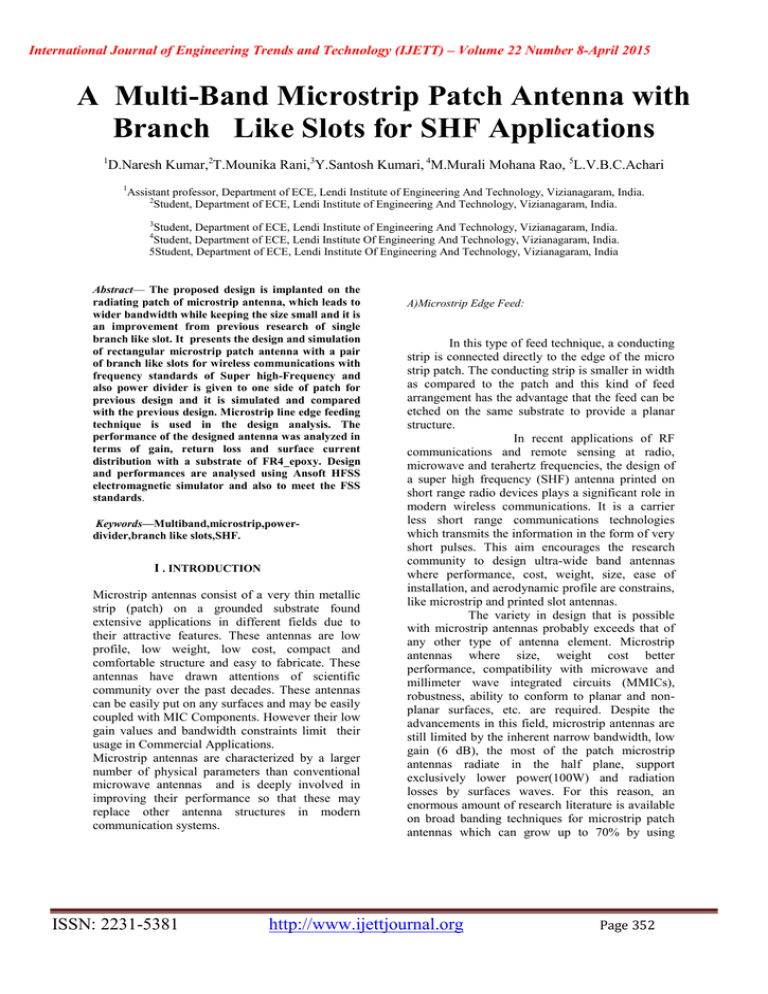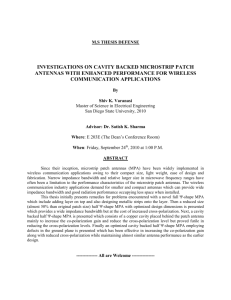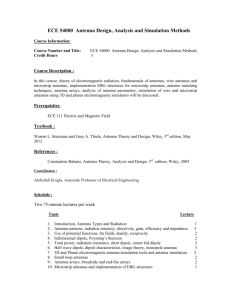A Multi-Band Microstrip Patch Antenna with
advertisement

International Journal of Engineering Trends and Technology (IJETT) – Volume 22 Number 8-April 2015 A Multi-Band Microstrip Patch Antenna with Branch Like Slots for SHF Applications 1 D.Naresh Kumar,2T.Mounika Rani,3Y.Santosh Kumari, 4M.Murali Mohana Rao, 5L.V.B.C.Achari 1 Assistant professor, Department of ECE, Lendi Institute of Engineering And Technology, Vizianagaram, India. 2 Student, Department of ECE, Lendi Institute of Engineering And Technology, Vizianagaram, India. 3 Student, Department of ECE, Lendi Institute of Engineering And Technology, Vizianagaram, India. Student, Department of ECE, Lendi Institute Of Engineering And Technology, Vizianagaram, India. 5Student, Department of ECE, Lendi Institute Of Engineering And Technology, Vizianagaram, India 4 Abstract— The proposed design is implanted on the radiating patch of microstrip antenna, which leads to wider bandwidth while keeping the size small and it is an improvement from previous research of single branch like slot. It presents the design and simulation of rectangular microstrip patch antenna with a pair of branch like slots for wireless communications with frequency standards of Super high-Frequency and also power divider is given to one side of patch for previous design and it is simulated and compared with the previous design. Microstrip line edge feeding technique is used in the design analysis. The performance of the designed antenna was analyzed in terms of gain, return loss and surface current distribution with a substrate of FR4_epoxy. Design and performances are analysed using Ansoft HFSS electromagnetic simulator and also to meet the FSS standards. Keywords—Multiband,microstrip,powerdivider,branch like slots,SHF. I . INTRODUCTION Microstrip antennas consist of a very thin metallic strip (patch) on a grounded substrate found extensive applications in different fields due to their attractive features. These antennas are low profile, low weight, low cost, compact and comfortable structure and easy to fabricate. These antennas have drawn attentions of scientific community over the past decades. These antennas can be easily put on any surfaces and may be easily coupled with MIC Components. However their low gain values and bandwidth constraints limit their usage in Commercial Applications. Microstrip antennas are characterized by a larger number of physical parameters than conventional microwave antennas and is deeply involved in improving their performance so that these may replace other antenna structures in modern communication systems. ISSN: 2231-5381 A)Microstrip Edge Feed: In this type of feed technique, a conducting strip is connected directly to the edge of the micro strip patch. The conducting strip is smaller in width as compared to the patch and this kind of feed arrangement has the advantage that the feed can be etched on the same substrate to provide a planar structure. In recent applications of RF communications and remote sensing at radio, microwave and terahertz frequencies, the design of a super high frequency (SHF) antenna printed on short range radio devices plays a significant role in modern wireless communications. It is a carrier less short range communications technologies which transmits the information in the form of very short pulses. This aim encourages the research community to design ultra-wide band antennas where performance, cost, weight, size, ease of installation, and aerodynamic profile are constrains, like microstrip and printed slot antennas. The variety in design that is possible with microstrip antennas probably exceeds that of any other type of antenna element. Microstrip antennas where size, weight cost better performance, compatibility with microwave and millimeter wave integrated circuits (MMICs), robustness, ability to conform to planar and nonplanar surfaces, etc. are required. Despite the advancements in this field, microstrip antennas are still limited by the inherent narrow bandwidth, low gain (6 dB), the most of the patch microstrip antennas radiate in the half plane, support exclusively lower power(100W) and radiation losses by surfaces waves. For this reason, an enormous amount of research literature is available on broad banding techniques for microstrip patch antennas which can grow up to 70% by using http://www.ijettjournal.org Page 352 International Journal of Engineering Trends and Technology (IJETT) – Volume 22 Number 8-April 2015 multilayer substrate and the gain can grow up to 30% by using microstrip patch antennas array. Notably, other broad banding techniques include: thicker substrate, shaping the patch antennas [1], stacking [2], aperture coupling [2], slot compact planar design [3] and parasitic patch either in another layer (staked geometry) or in the same layer (coplanar geometry) [4]. shows the geometry of Rectangular branch like slots with and without power divided microstrip patch Antenna. II. Antenna Design Specifications The antenna structure is having branch like slots in the ground plane with a kite shaped antenna. This structure is fed by a single micro strip line which ends in a power divider patch .The slot antenna is fed by a power which is divided micro strip line FR4 substrate of 62 mm with a dielectric constant of 4.2 is used in our design. The antenna is fed with 50ohm Micro strip line and is printed on the FR4 substrate (Lsub × Wsub) with the height (h) of 0.5 mm and relative permittivity r = 4.4 (dielectric constant) with loss tangent = 0.019. L & W denote the length & width of the dielectric substrate, respectively. A concave shaped patch is printed on the top side of the dielectric substrate. From the simulation and measurements the optimized dimensions are: TABLE1 Dimensions for below designs Fig.2.Designs for Rectangular branch like slots with and without power divider PARAMETERS SIZE (cm) PARAMETERS La 0.91 Lb SIZE (cm) III. Analysis of Antenna Geometry Lg 0.45 A) Patch and Substrate dimensions: 0.57 Lh 0.1 Lc 0.62 Li 0.25 Ld 0.387 Wa 0.56 Le 0.85 Wb 0.45 Lf 0.26 Wc 0.67 In this technique a slot is implanted on the radiating patch of microstrip antenna, which leads to wider bandwidth while keeping the size small[5].Comparison between simulated and measured return losses Rectangular slot loaded with and without power divider are verified by measurement[6].Results verify that this antenna is with compact size and wider bandwidth. Figure .2. ISSN: 2231-5381 TABLE2 Dimensions for patch and substrate X(cm) 0.19 Y(cm) 0.9 SubH(mm) 62 IV. Results and Discussions The simulated results for this modified antenna are optimized by varying position, length and width of Branch like shaped slot with and without power divider. http://www.ijettjournal.org Page 353 International Journal of Engineering Trends and Technology (IJETT) – Volume 22 Number 8-April 2015 Design2 Results: Design1 Results: Fig3(a)shows the return loss for the designed antenna Fig3(b)shows simulation results of the radiation patterns for the proposed patch antenna. Fig3(c)shows simulation results for Electric field distribution. Fig4(a)shows the return loss for the designed antenna. Fig4(b) shows simulation results of the radiation patterns for the proposed patch antenna. Fig4(c) shows simulation results for Electric field distribution. Rectangular branch like slots with and without power divider are being observed by the following simulated results. ISSN: 2231-5381 http://www.ijettjournal.org Page 354 International Journal of Engineering Trends and Technology (IJETT) – Volume 22 Number 8-April 2015 V.Comparision of Results: TABLE3 Compared results for both designs Branch like slots without power divider With power divider Operating frequency 10GHz 10GHz Return loss 6.2-14.14GHz 6.1-13.4GHz Substrate material FR4-Epoxy FR4-Epoxy PARAMETERS CONCLUSION The paper presents a Multi band Rectangular microstrip Antenna with Branch like Shaped Slots with and without power dividing for Super high frequency (SHF) applications with frequency ranging from 3GHz to 30GHz. The analysis is carried out by considering FR4-Epoxy substrate material using HFSS.The results show that the antenna is able to operate at 6.1 GHz and 14.14GHz frequencies with operating frequency at 10GHz. REFERENCES [1] Antenna Theory Analysis and Design, Restricted not for sale in North America Edition, Constantine A. Bal anis, Wiley, 2005 [2] R. Garg, P. Bhatia, I. J. Bahl and A Ittipiboon, Microstrip antenna design handbook, Artech House:New York, 2001. [3] Inc. NY, USA. Richard C. Johnson, Henry Jasik, ''Antenna Engineering Handbook'' Second Edition 1984, pp 7‐ 1 to 7‐ 14, McGraw Hill, [4] Kin Lu.Wong, Compact and Broadband Microstrip Antennas, John Wiley & Sons. 2003 [5] J. Huang (1983) The finite ground plane effect on the Microstrip Antenna radiation pattern, IEEE Trans. Antennas Propagate, vol. AP-31, no. 7, pp. 649-653 [6]Nader Engheta, Richard W. Ziolkowski, ―Meta material Physics & Engineering Explorations‖, Wiley-IEEE Press, June 2006. [7] Choi, S. H., J. K. Park, S. K. Kim, and J. Y. Park, \A new ultra-wide band antenna for UWB application," Microwave and Optical Technologies Letters, Vol. 40, No. 5, March 5, 2004. [8]J. S. Chen, ―Dual-frequency annular-ring slot antennas fed by a CPW feed and microstrip feed,‖ IEEE Trans. Antennas Propagation., vol. 53, no.1, pt. 2, pp. 569–571, Jan. 2005. ISSN: 2231-5381 http://www.ijettjournal.org Page 355

![EEE 443 Antennas for Wireless Communications (3) [S]](http://s3.studylib.net/store/data/008888255_1-6e942a081653d05c33fa53deefb4441a-300x300.png)
